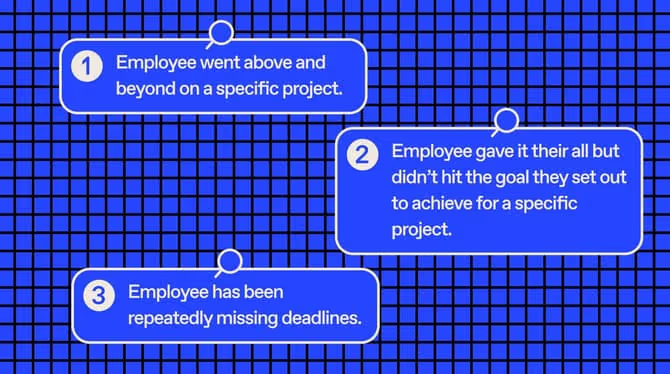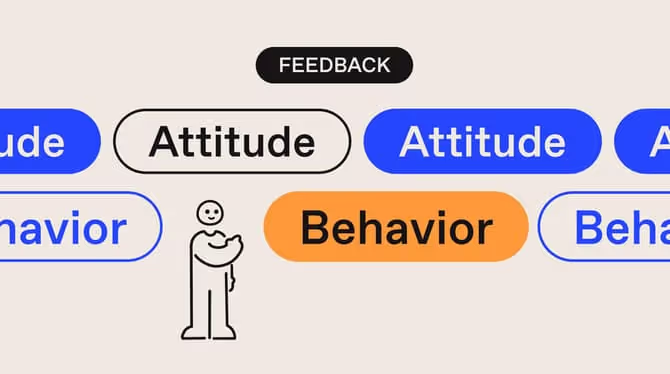How to give feedback to employees: A guide for managers

Employee feedback demystified: a comprehensive guide for managers
%20(1).png)
Great leaders don’t wait for annual performance reviews to offer employee feedback. They give timely, specific input and direction throughout the year, building trust and keeping performance on track.
When done right, feedback helps managers bring out the best in their teams. When done poorly, it can stall progress and damage morale. Giving good feedback to employees can be tricky, but it’s a learnable skill. And with the right habits and tools, managers can turn everyday conversations into moments that matter.
This guide shares actionable tips for providing feedback to employees to improve performance and create real momentum across teams.
What’s employee feedback?
Employee feedback is the ongoing practice of sharing observations that help individuals grow, perform, and stay aligned with team goals. There are two basic types of feedback: positive reinforcement and constructive criticism. Both are equally critical for an employee’s personal and professional development.
Positive reinforcement actively acknowledges what someone is doing well, reinforcing behaviors that contribute to strong outcomes. Constructive criticism, on the other hand, goes beyond pointing out areas for improvement. It offers clear direction on how to improve, encouraging learning over blame.
Why balanced feedback matters
Managers who balance positive reinforcement with constructive criticism open the door to:
- Higher employee engagement: When people understand how their contributions matter, they're more motivated to go above and beyond.
- Facilitated growth: Clear guidance helps employees identify skill gaps and develop targeted improvement plans that advance their careers.
- Enhanced morale and culture: A feedback-rich environment creates psychological safety, helping employees learn from mistakes and feel more comfortable taking risks.
- Strengthened trust: Meaningful feedback and open, honest communication build mutual respect between managers and team members.
How to improve employee feedback
Giving feedback isn’t always straightforward. But the more techniques managers have up their sleeves, the better they can build up their direct reports. Here are 10 best practices that can help.
1. Be closely attentive
It’s easy for good work to fly under the radar, especially in fast-paced environments. Mistakes, on the other hand, tend to stand out more. That’s why managers need to pay close attention to team members’ performance. Give prompt recognition for good work, and be consistent about reinforcing it.
2. Balance constructive criticism with positive reinforcement
Focusing too much on problems will wear employees down and shake their confidence. But skipping developmental feedback prevents people from reaching their potential.
The most effective employee feedback highlights what’s going well while addressing where workers can improve. To get the balance right, focus on behavior, not personality. Offer positive recognition often, while giving guidance when things need to improve.
3. Use technology to your advantage
Tools like Workleap Performance help managers provide more consistent, impactful feedback thanks to features like:
- AI-driven insights that consolidate 360-degree feedback into clear talking points
- Automated review cycles that make it easier to track progress and keep employee feedback flowing
- Guided reviews that help steer check-ins toward OKRs, obstacles, and next steps
Workleap Performance supports managers by keeping feedback timely, organized, and actionable. It also creates a record of conversations that helps track progress and spot patterns over time.
4. Avoid unsolicited advice
Even well-meaning feedback can backfire if the timing or intent isn’t clear. Before jumping in, consider whether the moment is right. Keep your feedback timely, and tie it back to goals you and the team member have already discussed.
5. Keep it private, always
Public criticism breaks trust and morale, causing damage that’s hard to recover from. Make sure all constructive feedback happens privately. If you have to acknowledge performance issues in front of others, stick to neutral comments and save the details for a private setting.
6. Foster a two-way conversation
Two-way conversations make criticism more effective and collaborative, even when the issue you’re addressing is big. Ask open-ended questions to understand the employee’s perspective, and listen without interrupting. Then, work together to create a plan that the employee believes in. This approach will get you buy-in from the employee and help you develop realistic, lasting solutions.
7. Lead with empathy
Employee feedback is more than a checkbox. It’s a chance to show care for someone’s growth and well-being. So offer empathy, but make sure it’s sincere. Putting yourself in the employee’s shoes makes it easier to act in their best interest.
That doesn’t mean ignoring performance gaps or problematic behavior. It means addressing issues clearly, compassionately, and constructively, whether you’re setting expectations or taking corrective measures.
8. Offer timely feedback
The sooner managers address issues, the easier they are to correct. The same is true for positive feedback: recognizing good work in real time strengthens the impact and makes the message clear.
Whether it’s positive reinforcement or constructive criticism, aim to share feedback within a few days, while the details are fresh.
9. Don’t be afraid to ask for a second opinion
Some situations are complex, especially for new managers. If you’re dealing with an emotionally charged or highly personal situation, check in with HR or a trusted leader before moving forward.
That doesn’t mean you have to follow the suggested approach. But an experienced third party can confirm that you’re on the right track or offer a better one. This step helps protect everyone involved, keeping the manager, the employee, and the business safe.
10. Keep feedback focused and intentional
Trying to tackle too much can dilute your main message, so stick to one key issue per feedback session. If there’s a connection between multiple concerns, group them thoughtfully. Otherwise, space them out over separate conversations.
Employee feedback examples
The right employee feedback approach depends on the context, the goal, and the individual. Most feedback falls into one of three categories: reinforcing, redirecting, or addressing performance issues.
Here’s how each type of feedback works in practice, with example language managers can use to deliver messages that stick.
Reinforcing feedback (aka positive feedback)
Reinforcing feedback improves employee engagement and highlights behaviors to repeat. It’s best delivered promptly and with specificity.
After a standout presentation
The employee led a high-stakes client pitch that impressed stakeholders: “Your storytelling in today’s pitch really captured the client’s goals. That clarity made a big difference.”
When someone steps up unexpectedly
An employee jumped in to support a colleague without being asked: “I noticed you helped Sara hit her deadline. That kind of initiative strengthens the whole team.”
During a big learning curve
A team member is taking on new responsibilities and gaining confidence: “You’ve picked up the new tools quickly. That progress shows strong adaptability.”
Redirecting employee feedback (aka constructive feedback)
Redirecting feedback helps employees adjust their approach without damaging trust. The goal is to support improvement, not assign blame.
When collaboration is off track
The employee often dominates meetings and interrupts others: “I’ve noticed some team members are hesitant to jump in. Let’s find ways to create more space for them.”
When communication isn’t landing
A manager receives feedback that an employee’s messages often lack clarity: “Your updates are important, but the team’s missing key details. Let’s outline what to include going forward.”
When deadlines slip
The employee missed two recent delivery dates: “Let’s talk about what’s getting in the way of hitting deadlines and how I can help you stay on track.”
Addressing performance issues (aka negative feedback)
Managers need to be clear and direct when employees fail to meet expectations. Focus feedback on facts, not assumptions. Then, come up with a plan.
After a pattern of missed goals
A direct report’s performance has been low across several projects: “Your recent deliverables aren’t meeting expectations. Let’s review what success looks like and create a support plan.”
When behavior affects the team
An employee regularly arrives late, which disrupts daily standups: “The late starts are holding up the team. I need you to arrive on time so we stay on track.”
Following client complaints
A customer flagged concerns about professionalism on a call: “That feedback was hard to hear. We need to rebuild that trust and make sure it doesn’t happen again.”
Explore Workleap’s AI features and improve your employee feedback process.
With the right tools and mindset, managers can transform employee feedback from something people fear into something they embrace.
Workleap Performance makes collecting 360 feedback easy and creates AI-generated insights based on real employee data. These insights highlight growth areas, offer coaching suggestions, and help managers share timely, meaningful feedback that supports development.
Try Workleap Performance for free to take the stress out of employee feedback and help your team thrive.
FAQs
What are the 3 Cs of feedback?
The three Cs of feedback are clarity, contextual meaning, and composure. Clarity ensures the feedback is specific and easy to understand. Contextual meaning ties the message to the employee’s work and goals. Composure means delivering feedback calmly and respectfully to protect trust and psychological safety.
What are the 5 Rs of feedback?
The five Rs of feedback form a simple framework for turning employee feedback into meaningful action. Here’s how it works in practice:
- Request: Ask for feedback proactively to encourage open communication.
- Receive: Listen actively without interrupting or reacting defensively.
- Reflect: Take time to consider the feedback and its implications.
- Respond: Follow up with questions or clarification to show engagement.
- Resolve: Agree on next steps and take meaningful action to improve.
The future of employee experience starts with you.


%20(1).avif)


.avif)
.avif)
.avif)





.avif)

